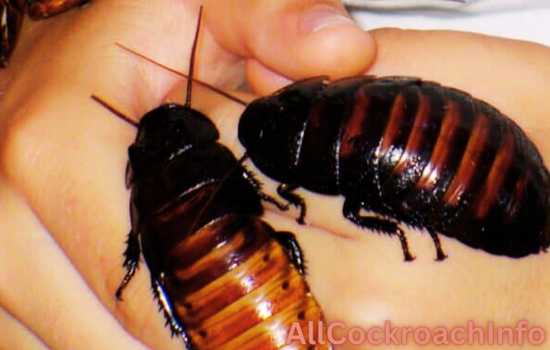Wood roaches are a species of roach that are commonly found in outdoor environments, while regular roaches, also known as German cockroaches, are typically found indoors. Wood roaches prefer forested areas and are attracted to rotting wood, while regular roaches are commonly found in kitchens, bathrooms, and other areas where food and water are present.
These two types of roaches can be distinguished by their habitat preferences and behavior patterns.
Wood Roach Vs Regular Roach Size
Wood roaches and regular roaches differ in size. While regular roaches are smaller, wood roaches can grow larger in comparison.
When it comes to the size of wood roaches versus regular roaches, there are some notable differences to consider. Let’s take a closer look at their respective sizes:
Wood Roach Size:
- Wood roaches, also known as wood cockroaches, are typically larger compared to regular roaches.
- They measure around 1 to 1.25 inches in length, making them relatively big insects.
- The males have wings that extend beyond their abdomens, while the females have shorter wings.
- Wood roaches have a flattened body shape, allowing them to maneuver easily through tight spaces.
Regular Roach Size:
- Regular roaches, such as German cockroaches or American cockroaches, are smaller in size compared to wood roaches.
- They usually range from 0.5 to 1 inch in length, making them slightly smaller than wood roaches.
- Regular roaches possess a compact body form and are known for their ability to squeeze into small cracks and crevices.
In comparison, wood roaches tend to be larger and more robust than regular roaches. The distinct size differences can be useful in distinguishing between the two species. However, it’s important to remember that size alone cannot determine which type of roach you might encounter.
Check More: Wood Roach vs Bed Bug
Each species has unique characteristics and habitats that can help further identify them.
Wood Roach Vs Regular Roach Bite
Wood roach bites are generally less harmful than regular roach bites. Wood roach bites cause mild irritation and itching, while regular roach bites can lead to severe allergic reactions and skin inflammation.
Have you ever wondered about the difference between wood roach bites and regular roach bites? While both types of roaches can bite, there are some distinctions to note. Let’s explore the characteristics of each bite and what sets them apart.
Wood Roach Bite:

- The wood roach bite is typically not harmful to humans.
- It is more of a defensive mechanism rather than an aggressive bite.
- This type of bite does not usually cause any physical pain or discomfort.
- Wood roaches primarily feed on decaying wood and are not inclined to bite humans.
Regular Roach Bite:

- Regular roaches, on the other hand, can bite both as a defense mechanism and as a way to obtain food.
- Their bites can cause mild irritation and discomfort to humans.
- Bites from regular roaches are more common in areas where food is easily accessible.
- It is important to note that regular roaches can carry harmful bacteria, so their bites may pose a risk of infection.
Wood roach bites are mainly harmless, while regular roach bites can cause mild pain and potentially transmit bacteria. Understanding the differences between these two types of roach bites can help you better identify the source of a bite and take appropriate action if necessary.
Remember, regular hygiene practices and proper pest control can help minimize the chances of encountering roach bites altogether. Stay informed and stay protected!
FAQs On Wood Roach Vs Regular Roach
What Is The Difference Between A Wood Roach And A Regular Roach?
Wood roaches and regular roaches are different species with distinct characteristics. Wood roaches are outdoor insects that prefer moist environments, while regular roaches are indoor pests. Wood roaches are attracted to lights and are harmless, while regular roaches are a nuisance to human health and food sources.
Are Wood Roaches Harmful To Humans?
No, wood roaches are generally harmless to humans. Unlike regular roaches, they do not pose a threat to human health or carry diseases. Wood roaches are outdoor insects and prefer to live in natural habitats like trees and logs, rather than infesting homes or buildings.
How Can I Differentiate Between A Wood Roach And A Regular Roach?
There are several key differences between a wood roach and a regular roach. Wood roaches are larger in size, have a more reddish-brown color, and are attracted to outdoor lights. Regular roaches, on the other hand, are smaller, darker in color, and commonly found infesting indoor areas like kitchens and bathrooms.
Can Wood Roaches Infest My Home?
Wood roaches typically do not infest homes or buildings. They prefer to live in natural habitats like trees, firewood, and leaf litter. However, if there is a significant presence of wood roaches near your home, they might occasionally enter through open windows or doors, but it is not a common occurrence.
Conclusion
Wood roaches and regular roaches may look similar, but they have distinct differences that should not be overlooked. Understanding these variations is crucial in determining the appropriate pest control measures to be taken. While both types of roaches thrive in damp environments, wood roaches prefer outdoor habitats such as woodpiles and mulch, while regular roaches tend to infest indoor areas.
Wood roaches are attracted to light and can be found swarming around porch lights during warm summer nights, whereas regular roaches are nocturnal and prefer to hide in dark corners during the day. Another significant distinction is that regular roaches are known carriers of diseases and allergens, posing potential health risks to humans, while wood roaches are generally harmless.
However, it’s important to remember that any type of roach infestation should be dealt with promptly and effectively. By understanding their differences, homeowners can tailor their pest control strategies accordingly, ensuring a roach-free living environment.
